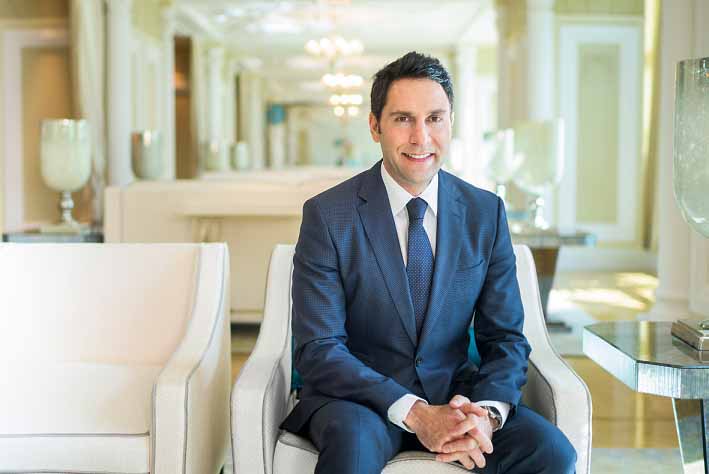RAK Tourism’s exciting projects
By viji Monday, 25 April 2016 9:18 AM

One of the fastest growing tourist destinations in the Middle East, Ras Al Khaimah witnessed a huge jump of 82% Chinese visitors in 2015 and an average stay of 8 nights for Russian tourists. Blessed with unique natural attractions such as the UAE’s highest mountains at 1,900m, canyons, mangrove forests, deserts and pristine beaches, it also has archaeological and historic sites dating back to 7,000 years ago. Aviamost spoke to the CEO of RAK Tourism Development Authority Haitham Mattar to know how they will be showcased and about its exciting projects on the anvil…
Ras Al Khaimah is known for its natural attractions. How do you plan to showcase this uniqueness to tourists?
When we landed here in the new role, we realized the only aspect capitalized on were its beaches. It has a stretch of 62kms of pristine beaches, but we realized there are many other assets. We made our first and largest study with TNS and consumer study in China, Russia, Germany, UK, GCC and India. And the insights were very useful as we realized that even if beaches were the greatest attraction for a number of markets, the number two was connecting with the culture, heritage, historical sites and that always depends on the markets. It came out in all the markets but what then is different is the motivation and priority as to whether beaches or historical sites are more important.
As you know we are one of the richest emirates when it comes to archaeological and historical sites and we have about 18 historical sites some going back to 7000 years such as the Palace of Sheba built of stone and we have a fort called Dia Fort built in the 16th century. In 1840 or so it played a major role in the British war defence as they didn’t have canons which could aim at that height so it still stands there as a testimony.
My favourite is Jazeera Al Hamra located behind Iceland. It was where Emiratis lived before oil was discovered. It has 200 year old houses made of coral. In 1976 they moved from the village to Abu Dhabi, around the time the Japanese introduced their cultured pearls, so they had to obviously move out.
We are now going through a restoration of the village by using the same materials used then. It has around 425 units of watch towers, traditional souks where they sold fish, houses and mosques. And we are reactivating this in 3 phases the first phase will take 2 – 3 years we have engaged a consultation firm PWC to work on this as a tourist attraction, post resurrection.
So we have this rich diversity with canyons and 1900m high mountains, which are the highest in the UAE and have proximity to the sea. They also had snow last year.
Can we see expect to see any mountain resorts soon?
It is in the study. But we have a paved beautiful road and it is used by many sports car makers to launch their cars as it has an inclination of only 5% which is almost like a Formula 1 track. And we have a total of 36 kms all the way up these mountains.
Don’t forget that we also have a very stunning desert which is different from the other deserts and it has lots of trees and also a wildlife protection area with deer, camels, oryx in their natural habitats where they are free to roam. So we have experienced a demand for these assets where people want to see more outside of the walls of their beautiful resorts.
What are your other attractions besides these, which are the most known and the least known?
We made a study again with TNS and found that the mountains are the least known to find out the awareness. And many people here do not know we have mountains and that the highest mountain is here. So we are trying to open some attractions one of the first which is almost complete is the Via Ferrata a natural climbing path with bridges made of ropes from one mountain to another, an adventure climbing site for experienced climbers with tour guides.
We are also looking to build the first 5 star camp in the mountains and we are also building the viewing deck in a park with food and beverage offerings where you can see the sea and the city below.
Are they built by the RAK Tourism Development Authority?
Yes. These offerings are all built by the RAK Tourism Board. We have identified around ten projects, and on these three of them we are investing directly while for others we have we are inviting private firms. One of them wants to build the longest zip-line in the world which is two and a half kms long and will be the longest in the world.
The most famous attractions of course are the beaches and the quality of the resorts. RAK’s historical sites are lesser known as they have not been exposed or promoted. And we are making efforts to showcase them. The desert is known for its camps and for their authentic Arabian experience and we are trying to bring all these assets to life.
In terms of marketing the destination, how are you planning to promote RAK, as a standalone destination or as a destination to go to after going to Dubai?
It depends on the market of course. We have existing charters from Russia through Coral flying directly from Russia directly to RAK we also have strategic partnership with Flydubai from Russia, which is our largest producer from Russia. We also have Air Arabia scheduled flights from Russia. Qatar Airways has direct flights from Russia and most European countries as well and we signed up with Air India Express which started landing here from 1st of April. So we are trying to round up the air lift to RAK directly. Our relationship with Emirates is very strong and right now 90% of our visitors are from Dubai airport from where you can reach a RAK resort area in 45 minutes on a very scenic, open highway.
The Russian market typically does not like to move around but they like to stay put. Now their average length of stay is 8 nights. Russians may travel less but they are staying more. It is like, ‘I have already paid the ticket so why not stay longer?’ As the evaluation of the ruble has reduced travel but the stay has gone up. So the revenue from the Russian market has gone up 110%, and there is stability now.
There is stability in the Russian market now.
The Russians love the sun and will travel. Think about it this way. In 2014 they were 42 million, in 2015, 29 Russians were million travelling outside Russia. And that’s not a small number by any scale so you still have a captive audience of 29 million.
This year we have seen an increase. So it’s coming around, through marketing efforts, strategic alliances efforts and air lifts we have done.
Some markets like Chinese don’t like to stay put but like to move around. We work together with Abu Dhabi and DTCM to do joint venture and try and combine our efforts. What we do is this: we do a city break in Dubai complemented by a beach and cultural break in RAK.
The Chinese average is small by comparison. Their stay is 1.5 nights average.
We recently went to China around three times and the response was tremendous. When they saw RAK’s heritage sites their eyes lit up. They want something new as they have skyscrapers in China.
We have signed up with Ctrip, the leading provider of travel services which will be announced at the ATM and signed there with the CEO. So it all depends on the market.
In 2015 you have accomplished a lot, what are your predictions for this year?
We have an ambitious target I would say. We saw 6.7% growth which is the highest in the GCC and higher than the global average of 4%. Our target is double this year.
What are your occupancy rates? Do you have enough rooms?
Yes we have. So far this year, we have had 19% growth in occupancy and this quarter we are hovering around 71%. March was the highest at 79%.
March our beach hotels did 80 % and Dubai too had 89%. Our city hotels did 74% which is not bad.
Anantara is coming up here on Mina Al Arab with close to 300 rooms next to Marjan island. It has beautiful beaches and it has got a wildlife reserve close to mangroves and you can see flamingoes, turtles and stingrays. So Anantara is going to preserve that like in the Maldives with underwater villas where you can see the wildlife below.
RAK is known as an ideal getaway for local Chinese. What are your strategies for local Chinese and Russian expats who comprise around 250,000 and 350,000 respectively?
They make up 50% of our biggest market. So we are ticking off a campaign where we are targeting this sector post ATM. During weekends or even weekdays when children go to school and during Ramadan we are launching a campaign to pick them up by Seawings at home and bring them here and they can see the skyline of Dubai and the beauty of RAK. We are subsidizing the deal to make it attractive, especially during the June-July period, so they can take an affordable holiday to a local spot before going on vacation.




























Add new comment